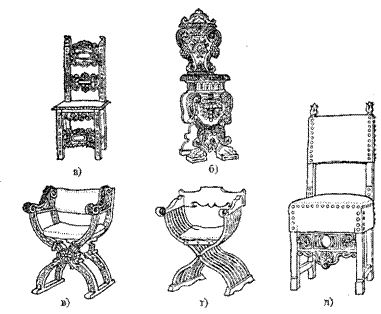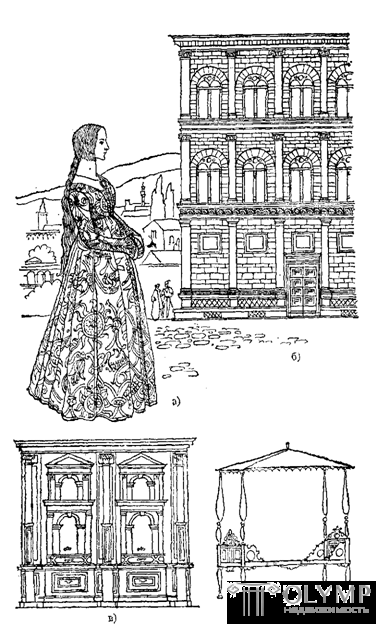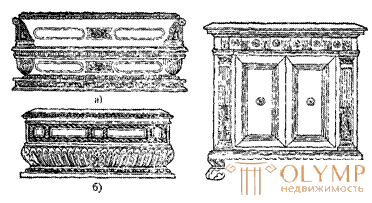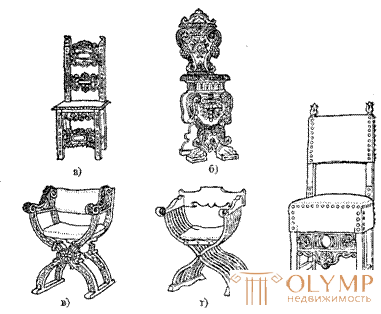
The Renaissance is a transitional period in the development of the countries of Western and Central Europe (in Italy of the XIV – XVI centuries, in other countries the end of the XV – XVI centuries) from medieval culture to the culture of the new time. The culture of the Renaissance was basically anti-feudal - it had a secular humanistic anti-church character, constantly turning to the cultural heritage of antiquity, as if reviving it (hence the name Renaissance by the French Renaissance). Creativity of the Renaissance figures was imbued with faith in the limitless possibilities of man, his will and mind, the pathos of the assertion of the ideal of a liberated creative personality, beauty and harmony of reality. In architecture, secular buildings — public buildings, palaces, city houses — began to play a leading role. Addressing the ancient heritage, the great architects of the era (Vrunelleschi, Alberti, Bramante, Pal-Ladio) created stately buildings - clear, harmonious, proportionate to man.
In architecture, new forms are beginning to dominate, associated with the revival of the ancient order system (Fig. 11).
In Italy, capitalist relations began to take shape earlier than in other European countries. Italian cities already in the XII — XIII centuries. dropped the oppression of feudal lords, some of them (for example, Florence, Venice) proclaimed themselves republics. Trade and craft began to flourish, and favorable conditions were created for the flourishing of secular culture.
The period of the mature Italian Renaissance stiyay falls on the second half of the XV and XVI centuries. Formed capitalist relations. The craftsman no longer works for the consumer, but for the market. Many urban artisans contain workshops with a large number of apprentices and apprentices. However, production is still not based on machine, but on manual labor. An early form of capitalist production was manufactory, which preceded the large-scale machine industry.

Fig. 1. The style of the Renaissance in the architectural and substantive environment: a — clothes, in - the closet, d - bed

Fig. 2. The main types of cabinet furniture of the Italian Renaissance: a - kassapanka, b - bridal chest, c - cupboard
In the Renaissance, shaping is already systematic: objects are first born on paper, in the form of projects, and only then they are carried out in these materials for these projects. If the previous styles developed organically from each other, then the Renaissance chose the artistic and cultural heritage of antiquity as the starting point.
In architecture, the leading place begins to belong to the Palazzo - the palace for wealthy representatives of the commercial and financial class. The palace is a rectangular building with a courtyard; Enfilade hall can be connected for celebrations. In order not to interrupt the suite, the stairs are placed in the corner parts of the building. Living quarters, galleries and staircases are decorated with wall paintings or carpets framed by sculptural frames or pilasters; the vaults are covered with stucco, the ceilings with wooden caissons.
The interiors of the palaces are characterized by monumental spatial compositions, the splendor of marble staircases, and the luxury of decorative furniture. Furniture begins to play a larger role than in the dwellings of the medieval period. Furniture in the XV century. few more: a chest for storing clothes and valuables, caskets, various kinds of stools and chairs, tables, beds, differing in accordance with the architecture with ease of construction and decor. A typical Italian product, the so-called kassapanka, is a chest-bench with a back and armrests (Fig. 3, a).
The main subject of the situation Florentine palaces and houses of rich citizens of the XV century. the chest remains - the wedding chest (Fig. 3, b). The original form of the chest is a long rectangular box with a heavy profile of the base. The cover of the chest on the inside is covered with painting. Such large Italian Renaissance artists as Pietro della Francesca (b. Ca. 1416–1492), Ghirlandaio (1449–1494), Giovanni Bellini (1430–1516), Sandro Botticelli (1444–1510) and others worked on the painting of wedding chests. .
In the second half of the XV century. Italian wedding lari acquire exquisite forms. They are made on a high stepped base with flat-cut fillets and profiles of semicircular rollers. The front side of the chest is richly decorated with carvings with gilding and painting.
Chests were made of various wood species (oak, yew, poplar, Italian cedar, etc.), but preference was given to the nut.
Joinery to the end of the XV century. reaches a high level. With the invention of the machine for the manufacture of thin sheets of wood (plywood), the technique of veneering was widely spread, and then the furniture was decorated with intarsia. Initially, intarsia was two-colored: black and white wood. Decorative motifs were widely used for decoration: curly stem, acanthus leaf, musical instrument, urban look, still life. Gradually, decorative motifs are expanding: figure compositions appear, grotesque, arabesque ornament. A painted tree is introduced, the intarsia becomes polychrome. The masters of intarsia were Baccio d'Agnolo, Giovanni di Verona, Benedetto da Mayo.
By the beginning of the XVI century. the architecture and interiors of the palazzo become richer, the walls and ceilings are decorated with frescoes, stucco, marble, complicated furniture.
About the middle of the XVI century. cabinets with architectural motifs appear: pilasters, cornices, consoles and brackets (Fig. 3, c) and the so-called cabinet cabinets with retractable drawers. Cabinet-cabinet consists of two parts: the lower, more solid with large doors and the upper, crushed by a set of drawers. The cabinets had a profiled base (base) or four supports. The lower part was completed with a load, and the upper part with a highly developed cornice or entablature.

Fig. 3. Furniture for the Seat of the Italian Renaissance: a - hard chair, b - carved boardwalk stupas, c - Savonarolls chair, d - stupas Dante, d - chair with leather upholstery
The beds were high with a canopy or curtains, with a high headboard and often a step.
Furniture for seating (Fig. 3) is diverse in purpose and form. The board chair (fig. 3, b) is widely spread, the front support and the back of which are often covered with carvings imitating the ancient Roman stone ornament. The chair in form comes from the seat - capacity, in which the design is freed from all unnecessary planes. Only the seat and partly back are left - and we have a diagram of a chair that has become firmly established for centuries. In order to preserve the rigidity, which was ensured by the continuous side walls, the backrest frame is now joined by cross-links, and the legs are connected by pronals (Fig. 3, a).
There are two types of X-shaped chairs: one - on eight supports connected by metal rods (Fig. 3, d) and the other on four (Fig. 3, e). The upper ends of the supports are connected with armrests, which gives the necessary rigidity. Decorated such chairs Chertosian mosaic, carvings, etc. The seat is a cloth or leather, fixed at four points. The back is sometimes decorated with embroidery and fringe. The use of fabric and leather in furniture products caused a change in composition. The plastic theme is contrasted with a pictorial beginning: a large, complex and catchy motif of the upholstery of the seat and back, reinforced by a fringe.
More modest chairs upholstered in leather, za rows of nails with large brass hats create a peculiar ornamental frame (Fig. 3, e).
In the types and forms of the tables of the Renaissance, there is a crossing and a simultaneous development of the principles of the early Middle Ages and antiquity: the smooth tabletop rests on massive sidewalls like the rectangular tables of Pompeii, but the sculptural character of the supports is much more vigorous than in the ancient prototype. From the Middle Ages passed a long refectory table on several pillars associated with the basement. Four-leg tables with retractable one or two drawers are in fashion.
In the northern provinces, the influence of the Gothic, in Venice and Umbria - Byzantine patterns; in Rome - ancient monuments. In Bologna, furniture was decorated with large decorative carvings, in Lombardy and Venice - with ivory inlays in the form of geometric patterns, known under the name of a Chertozian mosaic (Certosa Paviyskaya - a monastery near Milan). In Lombardy, intarsia of light and black wood was widely used.
The main center of the focus of Italian furniture art masters of the XV century. was the province of Tuscany with the main city of Florence. In the last quarter of the XV century. the tables of Bologna begin to be famous, more simple in form than the Florentine ones, with legs shaped like balusters and ornaments in the form of heads of large nails.
Antique forms are used in ornamentation of renovated furniture, decorative motifs - columns, pilasters, acanthus leaves, herms, cupids. A grotesque motif is introduced, developed on the basis of ornaments found on ancient Roman wall paintings. Grotesques - fantastic ornamental compositions, including climbing plant branches, figures of animals, birds, people. The furniture was also decorated with arabesques, various wickerwork, cornices, and garlands.
Что бы оставить комментарий войдите
Комментарии (0)